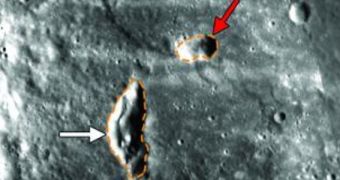Before the NASA MErcury Surface, Space ENvironment, GEochemistry, and Ranging (MESSENGER) spacecraft arrived in orbit around the innermost planet in our solar system, scientists believed that the this world contained no volatile compounds, of the type responsible for explosive volcanic eruptions. A new study by experts at the Brown University shows that to be false.
The team argues in a new study, published in the latest early online issue of the Journal of Geophysical Research: Planets, that Mercury indeed had volatile compounds, and that it retained them for longer periods of time than first thought. These conclusions are based on recent MESSENGER measurements, the group explains.
Experts say that the view started to change a couple of years ago, when the probe first started imaging pyroclastic flows on the surface of Mercury. These flows have long since solidified, but they point to a period in the planet's history when its geology was still pretty much active, and volcanic eruptions were commonplace. Recently, it was revealed that the last eruptions occurred more recently than previously estimated.
The Brown team determined in the new study that Mercury was in fact volcanically active for prolonged periods of time during its history, something that was previously thought to be impossible. These results may lead to a better understanding of the planet, as well as of its formation process.
Volatile compounds are a series of chemical compounds with low boiling points. In Earth's mantle, water and carbon dioxide are the most common, and they contribute to stirring up molten rock until it reaches the surface of the crust through volcanoes. The fact that Mercury once had a similar geology surprised investigators.
The research group, led by BU Department of Geological Sciences graduate student Tim Goudge, analyzed a total of 51 pyroclastic sites across the planet's surface, and determined that the vents through which the pyroclastic material made its way to the surface were eroded to different extents. This suggests that not all eruptions occurred during the same period or epoch.
“If [the blasts] happened over a brief period and then stopped, you’d expect all the vents to be degraded by approximately the same amount. We don’t see that; we see different degradation states. So the eruptions appear to have been taking place over an appreciable period of Mercury’s history,” Goudge says. Some of the youngest vents are between 3.5 to 1 billion years old.
This means that Mercury was geologically active throughout most of its 4.5-billion-year history, and only solidified its core around 1 billion years ago. “These ages tell us that Mercury didn’t degas all of its volatiles very early. It kept some of its volatiles around to more recent geological times,” Goudge concludes.

 14 DAY TRIAL //
14 DAY TRIAL //